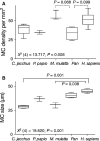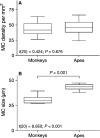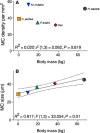Comparative analysis of Meissner's corpuscles in the fingertips of primates
- PMID: 26053332
- PMCID: PMC4475360
- DOI: 10.1111/joa.12327
Comparative analysis of Meissner's corpuscles in the fingertips of primates
Abstract
Meissner's corpuscles (MCs) are tactile mechanoreceptors found in the glabrous skin of primates, including fingertips. These receptors are characterized by sensitivity to light touch, and therefore might be associated with the evolution of manipulative abilities of the hands in primates. We examined MCs in different primate species, including common marmoset (Callithrix jacchus, n = 5), baboon (Papio anubis, n = 2), rhesus macaque (Macaca mulatta, n = 3), chimpanzee (Pan troglodytes, n = 3), bonobo (Pan paniscus, n = 1) and human (Homo sapiens, n = 8). Fingertips of the first, second and fourth digits were collected from both hands of specimens, dissected and histologically stained using hematoxylin and eosin. The density (MCs per 1 mm(2) ) and the size (cross-sectional diameter of MCs) were quantified. Overall, there were no differences in the densities of MCs or their size among the digits or between the hands for any species examined. However, MCs varied across species. We found a trend for higher densities of MCs in macaques and humans compared with chimpanzees and bonobos; moreover, apes had larger MCs than monkeys. We further examined whether the density or size of MCs varied as a function of body mass, measures of dexterity and dietary frugivory. Among these variables, only body size accounted for a significant amount of variation in the size of MCs.
Keywords: Meissner's corpuscles; body mass; dietary frugivory; digital dexterity; primates.
© 2015 Anatomical Society.
Figures







References
-
- Abercrombie M. Estimation of nuclear population from microtome sections. Anat Rec. 1946;94:239–247. - PubMed
-
- Bishop A. Use of the hand in lower primates. In: Buettner-Janusch J, editor. Evolutionary and Genetic Biology of Primates. Vol. 2. New York: Academic Press; 1964. pp. 133–225. In:, Vol.
-
- Bolanowski SJ, Pawson L. Organization of Meissner corpuscles in the glabrous skin of monkey and cat. Somatosens Mot Res. 2003;20:223–231. - PubMed
-
- Bolton CF, Winkelmann RK, Dyck PJ. A quantitative study of Meissner's corpuscles in man. Neurology. 1966;16:1–9. - PubMed
-
- Caruso G, Nolano M, Lullo F. Median nerve sensory responses evoked by tactile stimulation of the finger proximal and distal phalanx in normal subjects. Muscle Nerve. 1994;17:269–275. - PubMed
Publication types
MeSH terms
Grants and funding
LinkOut - more resources
Full Text Sources
Other Literature Sources

